Whether you’re preserving the fruits of your labor from a backyard tomato garden or storing those delicious summer tomatoes from the farmers’ market, canning is a great way to make a seasonal harvest last all year.
But what are the best tomatoes for canning?
The finest results come from canning tomatoes with a lot of meat, very little juice, and a long-lasting taste. Some of the most well-liked tomato varieties for home canning include the oblong-shaped Roma, San Marzano, and Amish Paste.

In a nutshell, the best canning tomatoes have the following features:
- A heavy, meaty texture
- A little amount of water
- Fewer seeds
- Flavor that lingers
Continue reading if you want to learn more about which tomato types produce the finest canned results.
Table of Contents
Remember This!
Only use entirely ripe, immaculate tomatoes when home preserving them, as any fungus, mold, or bacteria present may reduce the acidity, making them unsafe for human consumption.
1. Amish Paste

| Fruit Size | 8 to 12 ounces |
| Hardiness Zones | 3-8 |
| Light Required | Full sun |
| Height | 5 to 7 feet |
| Days to reach harvest from transplanting | 80 |
Originating in an Amish settlement in Wisconsin, Amish paste tomatoes are best (but not solely) used for creating tomato sauces and pastes, hence the name.
The Amish paste tomato plant yields large, meaty fruits that are easy to peel and perfect for canning.
Bright crimson in color, each Amish paste tomato can weigh anywhere from 8 to 12 ounces. They’re roughly egg-shaped with a point at the bottom.
The plants generate limited foliage, which promotes rapid fruit ripening when exposed to direct sunlight.
The meat is fairly dense, and, compared to the typical tomato, there are fewer number of seeds. They are intensely tomato-flavored, sweet, and somewhat acidic.
This type tends to produce three or four big fruits per truss, which may require staking to keep the branches from breaking under their weight.
2. Roma VF
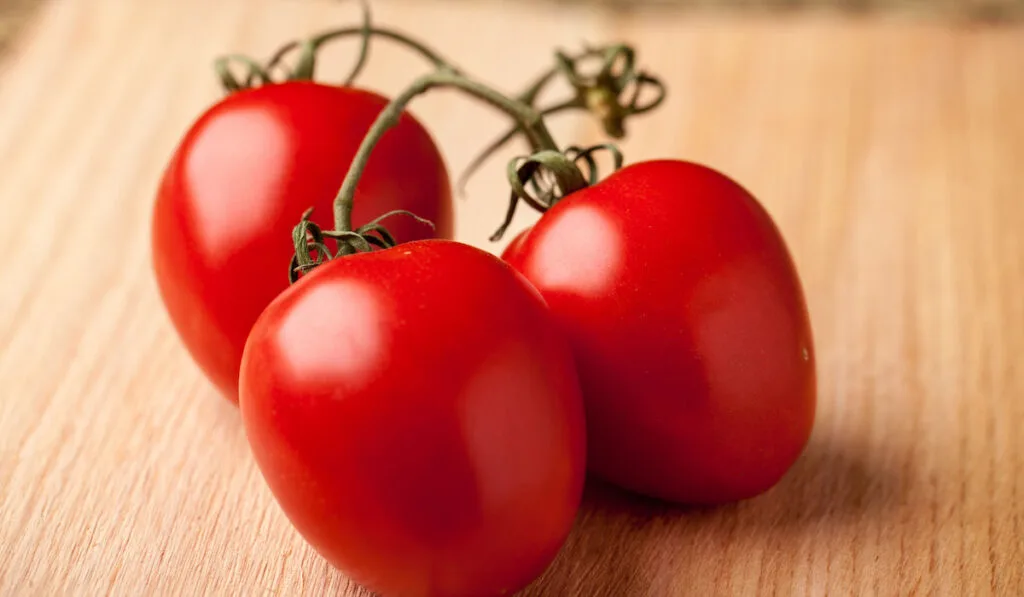
| Fruit Size | 3 ounces |
| Hardiness Zones | 3-12 |
| Light Required | Full sun |
| Height | 30 to 36 inches |
| Days to reach harvest from transplanting | 75 to 80 |
Roma VF tomatoes have been popular for a long time (since 1963), and their “VF” designation indicates that they are resistant to Verticillium and Fusarium wilts.
Regarding solid tomatoes, Roma is among the most well-liked. Its low water content makes it ideal for pasta and sauces, and it is also commonly used in canning.
The compact Roma tomato plants provide many bright red, pear-shaped plum tomatoes with exceptionally rich flavors.
The fruit matures in as little as 78 days and can weigh approximately 3 ounces when fully ripe.
Despite their compact stature, Roma plants flourish best when provided with cages or other forms of support. As a result, they get a far better, quality harvest.
Tomatoes from a Roma plant are ideal for commercial growers or home gardeners who want to harvest a large crop at once for canning.
3. San Marzano
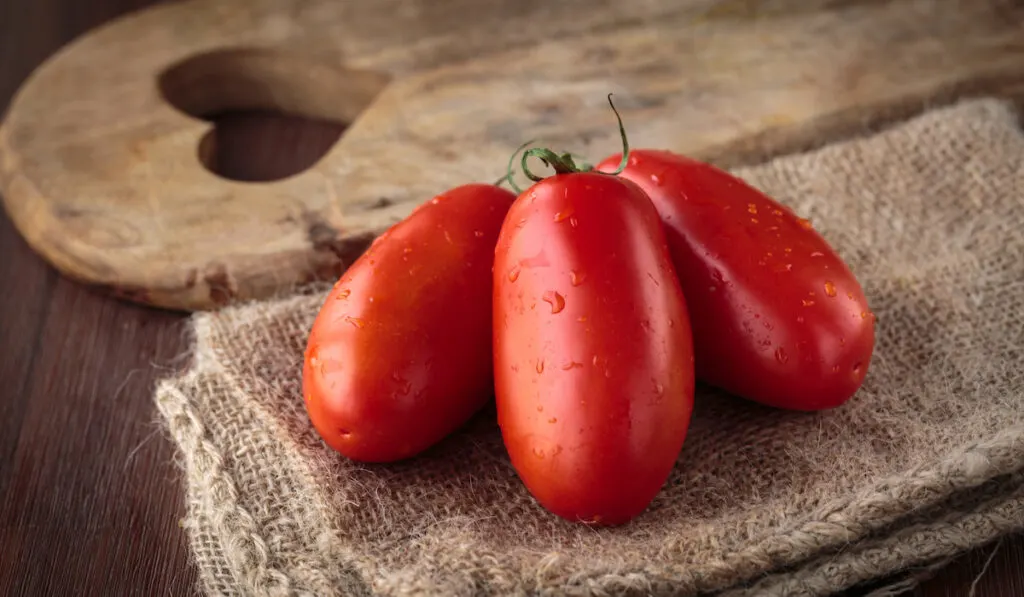
| Fruit Size | 3-6 ounces |
| Hardiness Zones | 5-10 |
| Light Required | Full sun |
| Height | 6 to 8 feet |
| Days to reach harvest from transplanting | 75 to 90 |
The San Marzano tomato is a variety of plum tomatoes.
However, it differs from the plum tomato most people are familiar with because it is longer and thinner, has a more pronounced pointed tip, and contains fewer seeds.
The San Marzano tomato was first developed in the Campania region of southwestern Italy and is named after the nearby town of San Marzano.
It is prized as a sauce tomato due to its meaty texture, low seed content, and ease of peeling.
Planting San Marzano tomatoes in your summer garden is worth every square foot because of their versatility in the kitchen and food preservation techniques like canning, drying, and making sauce.
This heirloom variety takes 75–90 days to mature from transplant and produces bright, vibrant crimson fruit. The average weight of one of them is between 3 and 6 ounces.
4. SuperSauce
| Fruit Size | 32 ounces |
| Hardiness Zones | 5-10 |
| Light Required | Full sun |
| Height | 18 to 20 inches |
| Days to reach harvest from transplanting | 70 |
Now is your chance to get your hands on the largest sauce tomato in the world! Tomatoes from SuperSauce are big, red, nearly seedless, full of flavor, and a breeze to peel.
One single SuperSauce tomato has the capacity to produce a whole jar of sauce because each tomato can weigh up to two pounds on its own!
This shows how a single SuperSauce harvest may provide an impressive number of tomato cans.
However, SuperSauce tomatoes are excellent for more than just canning; they also make a great salad tomato or a rich and flavorful hamburger slice.
These versatile, disease-resistant plants produce tomatoes throughout the summer, providing abundant, fresh, nutritious produce.
5. Bonny Best

| Fruit Size | 6-8 ounces |
| Hardiness Zones | 3-11 |
| Light Required | Full sun |
| Height | 4 to 6 feet |
| Days to reach harvest from transplanting | 80-85 |
For those interested in keeping historical varieties, note that the original crimson Bonny Best has been cultivated and maintained since its release in 1908.
In addition to yielding firm, round tomatoes that are great for slicing in salads and sandwiches, Bonny Best stands out as a source of consistent, meaty 6 to 8-ounce fruits that are perfect for canning.
These plants can reach heights of 4-6 feet. Therefore, staking and pruning are necessary. They mature in around 80 days and produce clusters of fruit.
If you live in a cooler region and plant tomatoes, you should know that Bonny Best is a reliable variety that thrives despite a shorter growing season.
6. Big Mama

| Fruit Size | 8-10 ounces |
| Hardiness Zones | 5-10 |
| Light Required | Full sun |
| Height | 40 to 48 inches |
| Days to reach harvest from transplanting | 80 |
Launched in 2002, when it comes to pasting tomatoes, the Big Mama is now the ultimate choice for home gardens.
The meat content of this tomato is exceptionally high, making it ideal to be used in sauces, soups, and preserves.
These plum-shaped tomatoes can grow as large as 5 inches in length and 3 inches in width.
When grown inside, they thrive in seed starters and then, when transported outside, yield bountiful crops from each plant. The vines will bear fruit right up until the first frost.
Big Mama tomatoes are simple to prep for use in the kitchen. They pair well with other foods but taste great on their own.
7. Atkinson
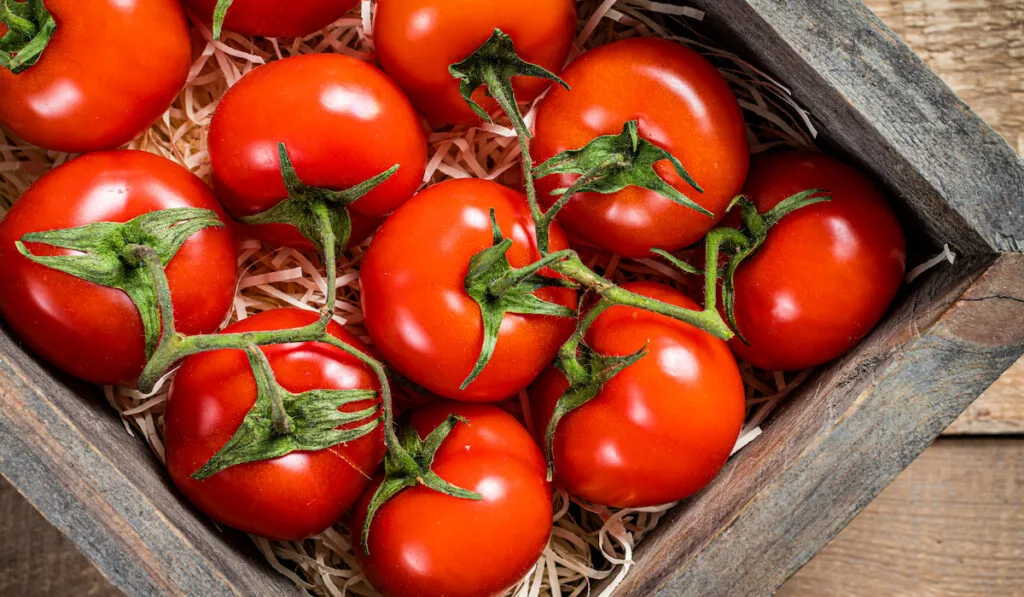
| Fruit Size | 6-10 ounces |
| Hardiness Zones | 11-12 |
| Light Required | Full sun |
| Height | 4 to 6 feet |
| Days to reach harvest from transplanting | 70-80 |
Atkinson tomatoes weigh between four and fourteen ounces each and have firm, meaty flesh, and their regular foliage vines grow to a height of around six feet.
They have a lovely flavor with a balanced sweetness and tartness. It’s fantastic whether used fresh in salads or sliced on your sandwich, canned, or processed into tomato soups or sauces.
Developed in 1966 at Auburn University, the Atkinson variety is a top pick for the South because of its robustness in the region’s typical climate and humidity.
8. Saucy Lady
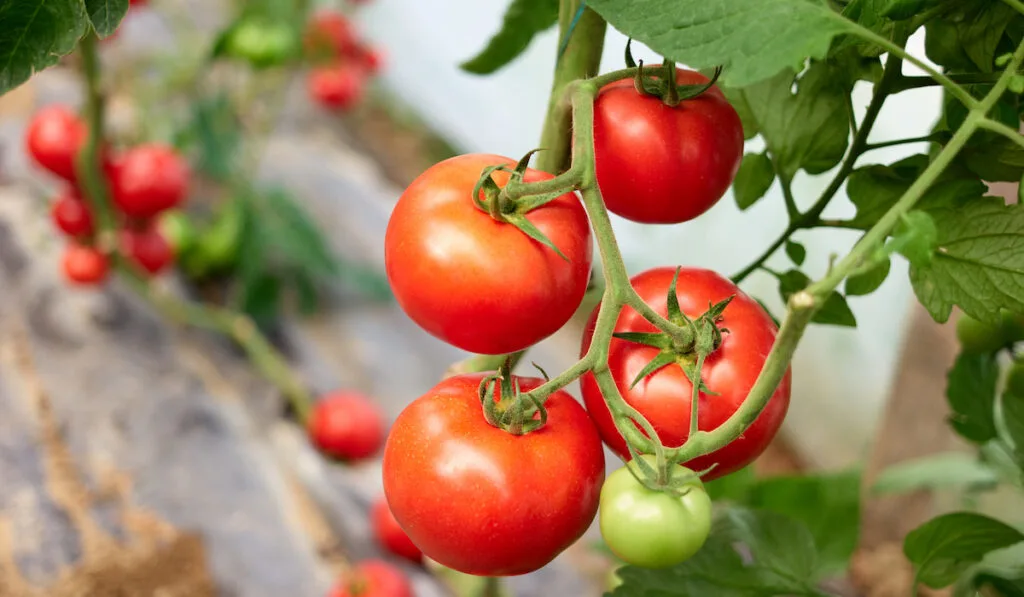
| Fruit Size | 3-4 ounces |
| Hardiness Zones | 3-9 |
| Light Required | Full sun |
| Height | 4 to 6 feet |
| Days to reach harvest from transplanting | 80 |
This is the ideal tomato for making sauce and preserving food in jars.
As far as tomatoes go, the Saucy Lady tomato is the gold standard.
When cooked down, the tomatoes from this vine become incredibly firm and have a deep crimson color, making for the silkiest pastes and sauces you’ve ever tasted.
The Saucy Lady tomato is a high-yielding variety that develops dense, round, and sweet fruits. These tomatoes weigh between 3 and 4 ounces and are just the right size for canning.
9. Red Pear

| Fruit Size | 1-2 ounces |
| Hardiness Zones | 11-12 |
| Light Required | Full sun |
| Height | 2 to 3 feet |
| Days to reach harvest from transplanting | 75 |
Canning tomatoes like Red Pear shows that a big size is not a must for good flavor.
Those pear-shaped fruits are delicious straight off the vine or in salads, but they also make a fantastic addition to canned or processed tomato soups and sauces.
Although only 1-2 inches in length, the clusters of fruit from this vintage heritage are perfect for canning or freezing and using later to enhance stews and soups throughout the colder months.
Because the vines of this cultivar can get quite tall, staking or trellising them is recommended, even though the fruits themselves aren’t particularly heavy.
10. Bradley
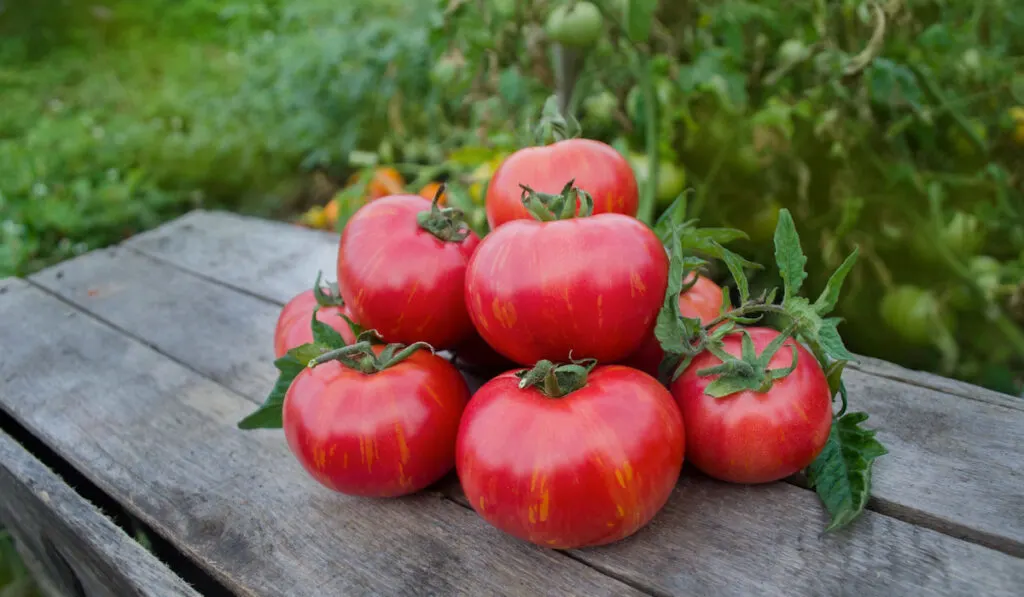
| Fruit Size | 8 ounces |
| Hardiness Zones | 3-10 |
| Light Required | Full sun |
| Height | 48 to 72 inches |
| Days to reach harvest from transplanting | 75 |
The Bradley is well regarded as a top choice for traditional Southern tomatoes. When it comes to classic Southern tomatoes, the Bradley is widely considered to be the best option.
The silky texture and lack of imperfections in its fruit have made it a timeless favorite.
Due to its semi-determinate nature, the harvest period will be shorter than other climbing varieties. However, Bradley tomatoes are ideal for canning and freezing because they ripen at the same time.
However, you should still expect to continue picking these tender, meaty 6-ounce fruits right up to frost.
Final Thoughts
As any professional chef or tomato lover knows, the perfect tomato-based recipe begins with selecting the right variety of tomatoes.
The flavor of tomatoes is well known, but whether you want to prepare a substantial sauce or a tasty salad, choosing the appropriate kind is key.
Consider a tomato with thick walls and a low seed and water count for canning and preserving so your final product isn’t overly watery.
Given the abundance of tomato types available, I’ve compiled a list of my favorites for canning and sauces.
However, remember that any tomato can be canned, and tomato sauces made from a blend of several tomato kinds can have a rich, distinct flavor. So don’t be afraid to experiment!
Resources
- https://heartscontentfarmhouse.com/best-tomatoes-for-canning/
- https://gardenerspath.com/plants/vegetables/best-canning-tomatoes/
- https://minnetonkaorchards.com/best-tomatoes-for-canning/
- https://www.johnnyappleseed.com/blog/best-tomatoes-for-canning-paste-making-and-sauce
- https://www.gardenfocused.co.uk/vegetable/tomato-outdoor/variety-amish-paste.php
- https://organorepublic.com/blogs/growing-guides/roma-vf-tomato
- https://gardenerspath.com/plants/vegetables/grow-san-marzano-tomatoes/
- https://www.thespruce.com/san-marzano-tomato-growing-guide-5205492
- https://www.burpeehomegardens.com/Vegetables/PlantDetails.aspx?plantid=5443
- https://garden.org/plants/view/769802/Tomato-Solanum-lycopersicum-Saucy-Lady/
- https://www.burpeehomegardens.com/Vegetables/PlantDetails.aspx?plantid=5085
- https://www.burpee.com/tomato-big-mama-hybrid-prod000966.html
- https://www.burpeeeurope.com/tomato-big-mama-hybrid/
- https://hosstools.com/product/saucy-lady-tomato/
- https://www.gardensalive.com/product/saucy-lady-hybrid-indeterminate-tomatoes
- https://www.wildroseheritageseed.com/store/p101/Tomato_-_Bonny_Best_%28IND%29.html
- https://www.smartgardener.com/plants/925-tomato-bonny-best/overview
- https://www.superseeds.com/products/bonny-best-tomato-72-days
- https://victoryseeds.com/products/atkinson-tomato
- https://www.seedsnow.com/products/tomato-atkinson
- https://mygardenlife.com/plant-library/tomato-atkinson-lycopersicon-esculentum
- https://www.ufseeds.com/product/red-pear-tomato-seeds/TORP.html
- https://mygardenlife.com/plant-library/pear-tomato-red-pear-lycopersicon-esculentum
- https://www.ufseeds.com/product/bradley-tomato-seeds/TOBRA.html
- https://www.tomatofest.com/Bradley_Tomato_Seeds_p/tf-0076.htm
- https://bankonseeds.com/pages/bradley-tomato-guide
- https://njaes.rutgers.edu/tomato-varieties/variety.php?Bradley
